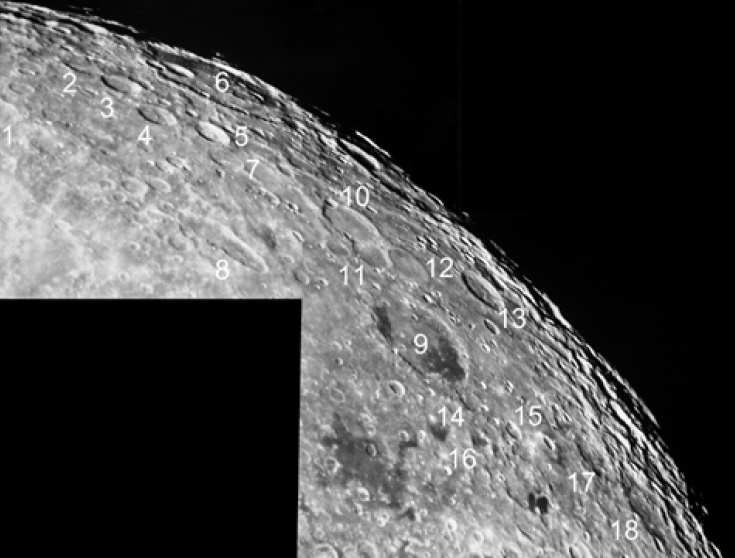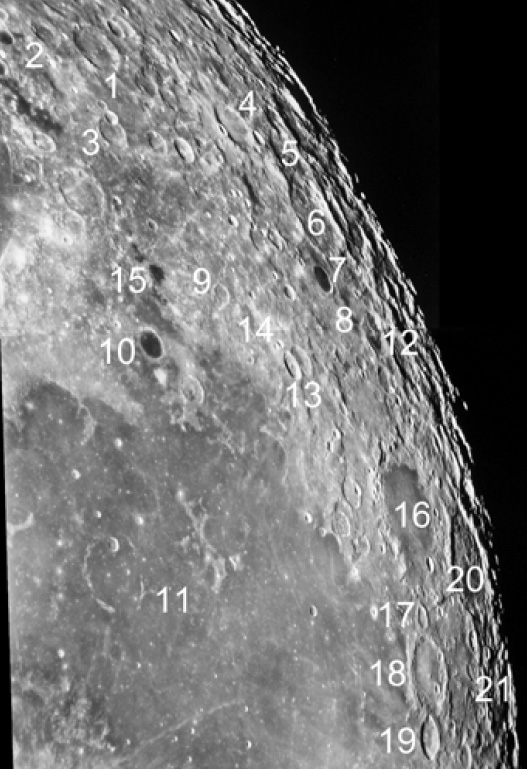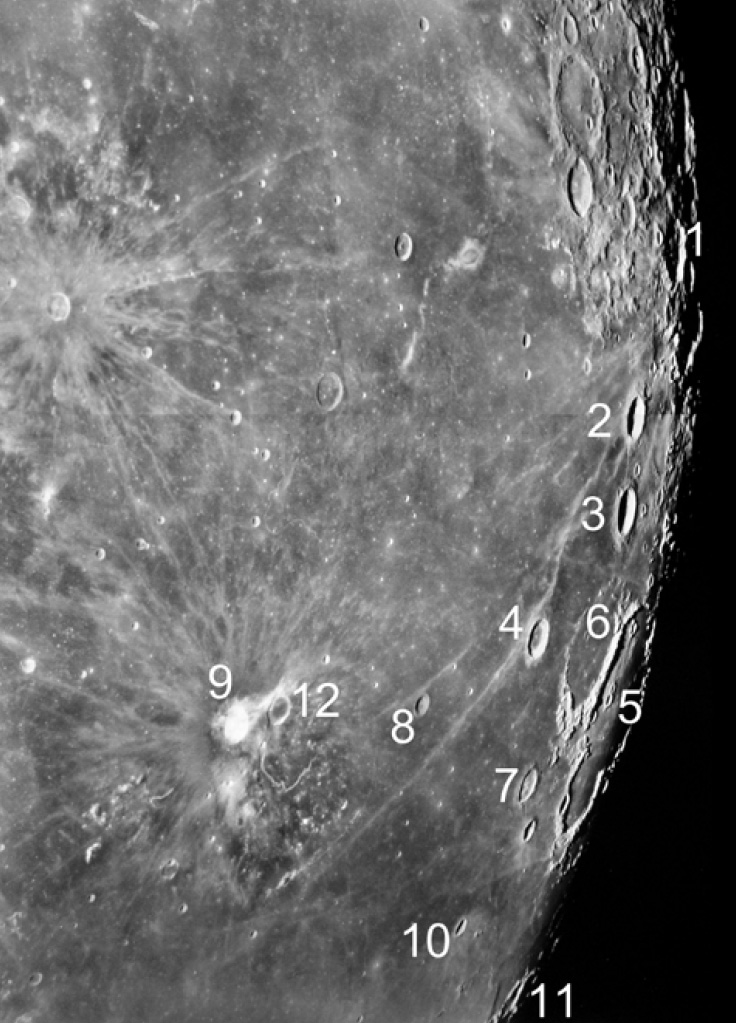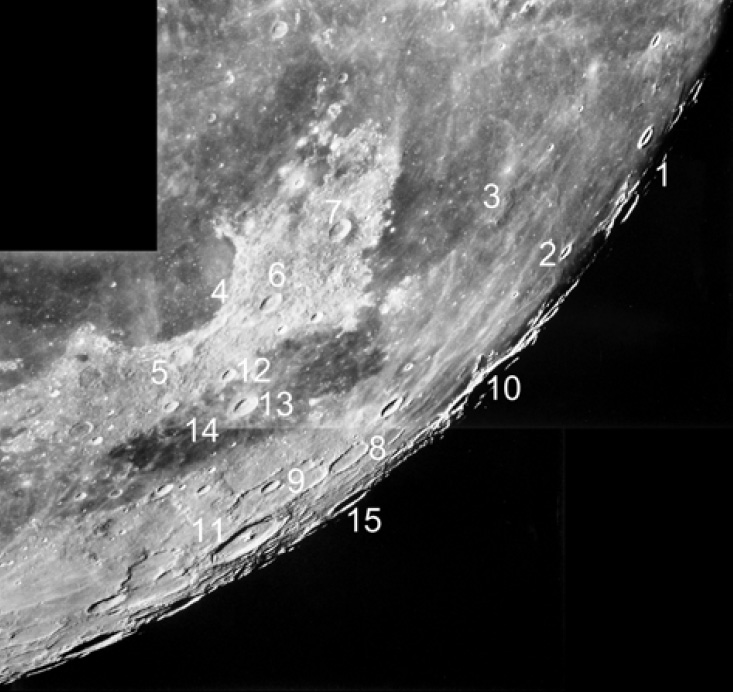Following the Terminator Part 7
By Joseph Cohen
First published Crux Apr-May 2008
Day 11-14
The areas near the west limb are becoming illuminated and the structures seen there and at the poles are subject to marked variation in position and appearance as a result of rotation and libration. Therefore some features may not be found until later in this or subsequent lunations. The terminator appears to move at a slower speed as it passes around the side of the globe. Because of these factors it is convenient to treat Day 11-14 as a single unit. The ray systems will develop over future days, but some will be useful now to assist in identifying objects. Many structures in the eastern portion of the globe become indistinct due to overhead lighting causing loss of contrast but filters and reducing aperture can assist in their identification. The best viewing for the east limb is when libration in latitude is negative (east) and for the North Polar area when libration in longitude (north) is positive.
Southern Hemisphere
South of the large CLAVIUS, a ‘gutter’ lies between the eastern GRUEMBERGER, MORETUS, SHORT and NEWTON chain, and the western BLANCANUS (Fig. 1, 1), KLAPROTH and CASATAS group. A line along the major axis of the Southern Cross passes through the center of Clavius to lie in the gutter, and later a south ray from TYCHO will be seen on the same line.

Figure 1 :
South-western limb of the Moon on Day 13, south is to the top.
1 Blancanus 2 Wilson 3 Kircher 4 Bettinus 5 Zuchius 6 Bailly 7 Segner 8 Schiller 9 Schickard 10 Phocylides 11 Nasmyth 12 Wargentin 13 Inghirami 14 Lehmann 15 Lacroix 16 Lehmann E 17 Piazzi 18 Lagrange
Images from the Consolidated Lunar Atlas maintained by the Lunar and Planetary Institute.
When well lit, Casatus shows two deep small craters across its north-south axis and a small crater invades its southwest wall. On the opposite side of the groove, NEWTON has two small craters at its north wall and touches the small SHORT’s west end with several small craters separating Newton from the elongated CABEUS at the limb. Casatus begins a chain along a western meridian whose next member is WILSON (Fig. 1, 2), a small shallow crater with damaged walls that almost touches KIRCHER (Fig. 1, 3), a well shaped smooth floored crater that is the first member of a group of three almost similar sized and shaped craters.
The second crater BETTINUS (Fig. 1, 4) has a central mountain, whilst ZUCHIUS (Fig. 1, 5), the third member, has several mountains in its floor. The three form an arc concave to the limb where BAILLY (Fig. 1, 6), the largest crater on the visible surface of the Moon, may be seen either slightly inland or at the limb depending on libration. Bailly presents as a long narrow oval with a domed floor containing a number of craterlets and two small craters at its south end. Later the DOERFEL MOUNTAINS may be seen at the limb opposite the crater. North of Zuchius, the shallow SEGNER (Fig. 1, 7) lies at the edge of a large sausage shaped dark area concave to the east that is devoid of any major structure but has the long SCHILLER (Fig. 1, 8) to its east and the large SCHICKARD (Fig. 1, 9) further north but slightly west of Schiller`s meridian. Schickard has a large dark patch in its north floor and a smaller one at its southeast floor, both patches retaining their darkness in the following days.
West of the middle of the dark featureless area and a little southwest of Schickard is an interesting group of three craters. The southern and largest of the group PHOCYLIDES (Fig. 1, 10), has a higher north east wall and is close to the small low walled NASMYTH (Fig. 1, 11) lying between it and the unique WARGENTIN (Fig. 1, 12.) A peak on Phocylides’s east wall throws a shadow onto its floor, whilst Wargentin in the past was filled with molten lava that overflowed, destroying the rampart of its north wall. Perhaps the smooth area to its north lying between Schickard and INGHIRAMI (Fig. 1, 13), a moderate sized crater north west of the latter, is the result of the overflow. Almost touching Schickard`s north wall is the small oval LEHMANN (Fig. 1, 14) with a small craterlet at its north and south walls. Following the same meridian as Schickard to the north, we pass between the small western LACROIX (Fig. 1, 15) with a craterlet at its south wall and the slightly larger and longer eastern LEHMANN E (Fig. 1, 16) that has a dark patch in its south floor and has the shape of a flying saucer. One Schickard’s north-south diameter further north, a small dark distinctive patch with a craterlet invading its north side appears like a deformed butterfly and is a useful land mark. A radial line from the patch to the west limb crosses the north end of PIAZZI (Fig. 1, 17) and the south end of LAGRANGE (Fig. 1, 18.) Piazzi is a large long narrow irregular crater with dark patches along its east floor and a short ridge near its centre. The larger Lagrange whose south end touches the northwest side of Piazzi has an irregular shape and fragmented walls. The same radial line crosses the north tip of BOUVARD, a long narrow slit at the rim.
North of the “butterfly”, VIETA (Fig. 2, 1), with a small central crater, is separated by a tiny craterlet from FOURIER (Fig. 2, 2) a smaller crater with a double craterlet near its east wall. North of Vieta the smaller CAVENDISH (Fig. 2, 3) can be recognized by the small crater CAVENDISH E invading its southwest wall and the latter having a smaller one at its south end.

Figure 2:
Southern section of the western limb of the Moon on Day 13, south is to the top.
1 Vieta 2 Fourier 3 Cavendish 4 Byrgius 5 Lamarck 6 Darwin 7 Cruger 8 Lacus Aestatis 9 Fontana 10 Billy 11 Oc. Procellarum 12 Rocca
13 Sirsalis 14 Sirsalis Cleft 15 Zupus 16 Grimaldi 17 Lohrmann 18 Hevelius 19 Cavalerius 20 Riccioli 21 Sven Hedin
Images from the Consolidated Lunar Atlas maintained by the Lunar and Planetary Institute.
Cavendish begins a series of small craters (see Day 9-10) that curves to the west to meet BYRGIUS (Fig. 2, 4) in the same latitude, whose craterlet A on its east wall will become the centre of a major ray system. A small crater and a craterlet also lie at Byrgius’s north west edge, separating it from a long combined crater whose south portion LAMARCK (Fig. 2, 5) is separated from the north DARWIN (Fig. 2, 6) by a waist, where a number of craterlets lie. At the limb and south of Lamarck, the ROOK MOUNTAINS may be seen stretching to the south as far as Lagrange. They are the south portion of the outer rim of the ORIENTALE basin, a huge crater in the unseen part of the Moon. Northeast of Darwin’s north tip the small very dark CRUGER (Fig. 2, 7) is easy to find south of the smooth small LACUS AESTATIS (Fig. 2, 8) and is a useful guide to the surrounding structures as it keeps its darkness even at Full Moon. It is east of a line that separates the south and north parts of the outer rim of the Oriental basin. FONTANA (Fig. 2, 9), a small crater with two craterlets outside its northeast wall, lies halfway along and south of a line running between Cruger and the small dark BILLY (Fig. 2, 10) that lies at the coast of the middle bay of OC. PROCELLARUM (Fig. 2, 11.) Darwin points north to ROCCA (Fig. 2, 12), a long thin crater with a dark patch in its north floor and flanked by two smaller similar pointed craters. It is recognized by the two small squashed craterlets at its north end similar to, but smaller than SIRSALIS (Fig. 2, 13.) At the limb, the CORDILLERA MOUNTAINS may be seen and are the north part of the ORIENTALE basin, stretching from the north of Rocco to the south of Darwin. East of Rocco, near the west coast of Oc. Procellarum, the small Sirsalis has a central mountain and compresses its western twin SIRSALIS A, both appearing as thin ovals. A rille, the SIRSALIS CLEFT (Fig. 2, 14), the longest on the Moon, begins at a tiny craterlet in the sea southeast of SIRSALIS D, a small shallow crater at the coast opposite an inland long north range starting from the north end of its parent. The cleft passes south close to Sirsalis, then between Cruger and Fontana to reach Byrgius. Note that Billy, ZUPUS (Fig. 2, 15), Cruger and a dark line between it and the dark area in Rocca resemble the shape of Canis Major when the area is seen with overhead lighting.
Northern Hemisphere
Crossing to the northern hemisphere, a number of moderate to large sized craters form a double row near the west limb. Due to foreshortening, most appear to have their north-south axis longer than their east-west axis, giving a false impression of their true shape. The most obvious crater is the large oval dark floored GRIMALDI (Fig. 2, 16) at the west end of the line used to separate the two hemispheres. It looks like a Mare and is visible to the naked eye at Full Moon. Its low crumbled walls are inconspicuous and a number of craterlets lie about its north and east side. Grimaldi begins the north series of the east chain and to its north the small elongated LOHRMANN (Fig. 2, 17) is close to the large oval HEVELIUS (Fig. 2, 18) that has a central mountain on a ridge and several craterlets at its west wall. Hevelius touches the small CAVALERIUS (Fig. 2, 19) that has several small mountains on its floor and a craterlet at its north and south ends giving it the appearance of a flying saucer.
West of Grimaldi and starting the west series, the large RICCIOLI (Fig. 2, 20) almost touches Grimaldi’s west side and has pointed ends with a craterlet at its peaks. It has a dark area at its north end and a ridge of mountains south of the junction of its light and dark floor. The D’ALEMBERT MOUNTAINS lie to its west at the limb. North of Riccioli, in the same meridian, the large irregular walled SVEN HEDIN (Fig. 2, 21) has a broken ridge on its north south axis and has the large Hevelius to its east as a guide when it is in shadow. A small craterlet separates it from the smaller but deeper looking elongated oval OLBERS (Fig. 3, 1) with a craterlet at its east wall.

Figure 3:
Northern section of the western limb of the Moon on Day 13, south is to the top.
1 Olbers 2 Cardanus 3 Krafft 4 Seleucus 5 Otto Struve 6 Eddington 7 Briggs 8 Schiaparelli 9 Aristarchus
10 Lichtenberg 11 Ulugh Beigh 12 Herodotus
Images from the Consolidated Lunar Atlas maintained by the Lunar and Planetary Institute.
Several craterlets lie between it and the ‘flying saucer` Cavalerius to its east. Olbers has a craterlet OLBERS A at its northwest wall that will become the centre of a corona that will hide its parent. On almost the same meridian and transferring the combined lengths of the last two craters to the north and slightly east, the smaller oval but deeper looking CARDANUS (Fig. 3, 2) is followed by KRAFFT (Fig. 3, 3) and still further north SELEUCUS (Fig. 3, 4), all similar in size and shape like a set of triplets. West of Cardanus the thin VASCO DA GAMA lies at the rim ready to explore another world. West of Seleucus the long large OTTO STRUVE (Fig. 3, 5) is joined to a smaller elongated crater with a craterlet on the north part of its east wall giving them a bilobar appearance. Do not mistake the large EDDINGTON (Fig. 3, 6) [Otto Struve A] that lies between Otto Struve and Seleucus for Struve. Edington has a very low east wall and a high west wall that it shares with O. Struve and is quite prominent when illuminated. Both craters are east of the HERCYNIAN MOUNTAINS at the limb. BRIGGS (Fig. 3, 7) is the larger of two small craters lying east of Struve’s north lobe. Briggs and Seleucus form a triangle with the small SCHIAPARELLI (Fig. 3, 8) to the east. This small crater lies between the two west rays from the ARISTARCHUS (Fig. 3, 9) complex.
Moving north the same distance as between them, Briggs and Seleucus are in the same meridian as the small LICHTENBERG (Fig. 3, 10) that has a craterlet near its west side and is radial to ULUGH BEIGH (Fig. 3, 11) the largest, broadest and most eastern of a group of craters at the limb. A line from HERODOTUS (Fig. 3, 12) west of Aristarchus through Lichtenberg also crosses the crater. Slightly to the north, the shorter thinner LAVOISIER (Fig. 4, 1) is the largest and most southern member of another local cluster of small thin craters and a small isolated crater to its east serves as a guide to its position. Transferring the distance between the last two small guide craters to the north of Lavoisier, GERARD at the limb is the same size and shape as Lavoisier and has the small HARDING (Fig. 4, 2) slightly inland as a guide.

Figure 4 :
North-western limb of the Moon on Day 13, south is to the top.
1 Lavoisier 2 Harding 3 Rumker 4 Jura Mountains 5 Bianchini 6 Sharp 7 Mairan 8 Oenopides 9 Babbage 10 Repsold 11 Pythagoras 12 Foucault 13 Harpalus 14 M. Frigoris 15 Cleostratus
Images from the Consolidated Lunar Atlas maintained by the Lunar and Planetary Institute.
An east radial line crossing the last two craters also crosses the low ear shaped RUMKER (Fig. 4, 3) at twice the distance between the two craters. Rumker’s low height means it will only be seen with tangential lighting when near the terminator. The same reference line points to the southwest end of the Long Island. Another useful reference line is to project the Foucault-Harpalus line to the south where it bisects the JURA MOUNTAINS (Fig. 4, 4) and Sinus Iridum. This line also crosses a line of similar well defined small craters in the Long Island with BIANCHINI (Fig. 4, 5) to the east and SHARP (Fig. 4, 6) and MAIRAN (Fig. 4, 7) to the west. North of Sharp are two obvious craterlets and a line from Sharp through the east craterlet passes through the junction of OENOPIDES (Fig. 4, 8) and BABBAGE (Fig. 4, 9) whilst the line through the west craterlet crosses the north end of the long REPSOLD (Fig. 4, 10) and the middle of REGNAULT closer to the limb.
It might be easier to locate the north limb craters by moving to the west polar area and finding the prominent PYTHAGORAS (Fig. 4, 11) with its central mountain and the large Babbage with a large and a small craterlet inside its south wall. Babbage lies on a radial line from FOUCAULT (Fig. 4, 12) at the north edge of the Long Island and HARPALUS (Fig. 4, 13) in M. FRIGORIS (Fig. 4, 14) with Pythagoras touching Babbage’s northeast wall. The smaller oval Oenopides touching Babbage’s west side is inland to XENOPHANES, a longer thin crater with a central ridge. It is lying at the limb on a line from Harpalus through Oenopides. To its east the small CLEOSTRATUS (Fig. 4, 15) is close by while to its west is the longer wider Regnault. A little inland to the latter, the long thin crater Repsold stretches to the south almost touching the thin smaller GALVANI’s east wall. These limb structures may not be visible early in this period or when libration is unfavourable.